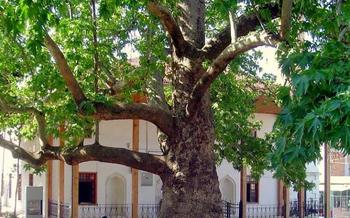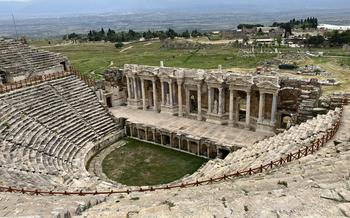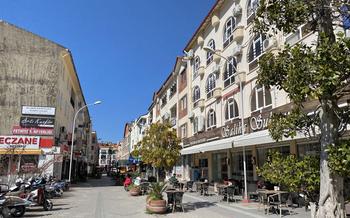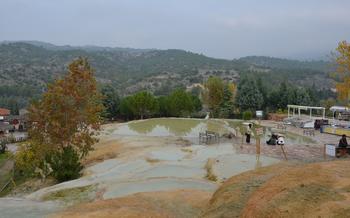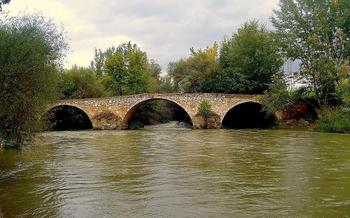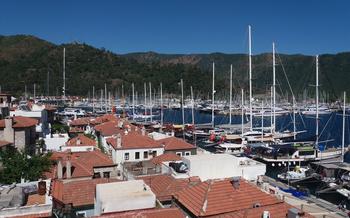
Pamukkale Natural Park
- Pamukkale Natural Park: A UNESCO World Heritage Site
- Location and Accessibility
- Natural Wonders
- Historical Ruins of Hierapolis
- Pamukkale Hot Springs: A Sanctuary for Relaxation and Rejuvenation
- Swimming in the Travertine Pools
- Exploring the Ancient City of Hierapolis
- Hot Air Balloon Rides
- Accommodation Options
- Dining Experiences
- Shopping in Denizli
- Day Trips from Denizli
- Insider Tip: Unveiling the Hidden Gems of Pamukkale
Pamukkale Natural Park: A UNESCO World Heritage Site
Pamukkale Natural Park, a mesmerizing natural wonder located in Denizli, Turkey, stands as a testament to the extraordinary power of nature and human history. Its name, meaning "cotton castle" in Turkish, aptly describes the unique geological formations that dominate the landscape. The park encompasses a vast expanse of glistening white travertine terraces, cascading thermal springs, and ancient ruins of the Roman city of Hierapolis, creating a breathtaking and awe-inspiring spectacle that has earned it recognition as a UNESCO World Heritage Site.
Historical significance: Pamukkale's history dates back to the 2nd century BC when the ancient Greek city of Hierapolis was established on the site. The city thrived as a renowned spa town due to its abundant hot springs, which were believed to possess therapeutic properties. The travertine terraces, formed by the gradual deposition of calcium carbonate from the thermal waters, created a surreal landscape that attracted visitors from across the Roman Empire.
Unique geological formations: The most striking feature of Pamukkale is undoubtedly its travertine terraces, which resemble a cascade of pristine white cotton balls flowing down a hillside. These terraces, formed over thousands of years by the gradual precipitation of calcium carbonate from the hot springs, create a mesmerizing spectacle that is unique in the world. The thermal waters, rich in minerals, continue to flow over the terraces, replenishing and maintaining this natural wonder.
Rich biodiversity: Pamukkale Natural Park is home to a diverse array of flora and fauna, thriving in the unique microclimate created by the thermal springs. The terraces provide a habitat for various plants, including endemic species found nowhere else in the world. The park also supports a variety of bird species, attracted to the area by the abundance of water and vegetation.
Cultural importance: Pamukkale holds significant cultural importance as the site of the ancient city of Hierapolis. The city, founded in the 2nd century BC, was a prominent center of trade and culture in the Roman Empire. Its well-preserved ruins, including an amphitheater, temples, and colonnaded streets, offer a glimpse into the grandeur and sophistication of Roman civilization.
Location and Accessibility
Pamukkale Natural Park is conveniently located in the Denizli Province of Turkey, making it easily accessible from major cities such as Istanbul, Ankara, and Izmir. The closest city to the park is Denizli, which is only 18 kilometers away. From Denizli, visitors can take a short bus ride or taxi to reach the natural park.
Transportation options to Pamukkale are varied and convenient. For those arriving by plane, the nearest airport is Denizli Çardak Airport, which is located approximately 60 kilometers from the park. From the airport, visitors can take a taxi or rent a car to reach Pamukkale. Alternatively, there are regular bus services from major cities to Denizli, from where visitors can transfer to local buses or taxis to reach the park.
Guided tours are available for those who prefer a more structured and informative experience. These tours typically include transportation to and from the park, as well as a knowledgeable guide who can provide insights into the history, geology, and cultural significance of Pamukkale. Visitors who prefer to explore at their own pace can opt for a self-guided visit, which allows them to wander through the park at their leisure.
The best time to visit Pamukkale is during the shoulder seasons (April-May and September-October) when the weather is pleasant and the crowds are smaller. During the summer months (June-August), temperatures can soar, making it less comfortable to explore the park. In the winter (November-March), the weather can be cold and rainy, affecting the overall experience.
Natural Wonders
Pamukkale Natural Park is renowned for its unique geological formations, including the iconic travertine terraces. These cascading white cliffs are formed by the deposition of calcium carbonate minerals from hot springs. The terraces resemble a frozen waterfall, creating a surreal and breathtaking landscape.
The park also features thermal springs, which have been revered for their therapeutic properties since ancient times. Visitors can soak in the warm, mineral-rich waters of the springs, which are believed to have healing effects for various ailments.
The natural beauty of Pamukkale extends beyond the travertine terraces and thermal springs. The park is surrounded by picturesque limestone cliffs and lush vegetation. Visitors can explore hidden caves and underground tunnels, providing a glimpse into the subterranean wonders of Pamukkale.
Historical Ruins of Hierapolis
In the heart of Pamukkale Natural Park lies the ancient city of Hierapolis, a testament to the rich history and cultural heritage of the region. Founded in the 2nd century BC by Eumenes II, king of Pergamon, Hierapolis flourished as a significant city in ancient Phrygia. Its strategic location along trade routes and its proximity to the healing waters of Pamukkale's thermal springs contributed to its rise and prosperity.
Over the centuries, Hierapolis grew into a bustling metropolis, home to a diverse population of Greeks, Romans, and Jews. It became a renowned center for medicine and healing, attracting visitors from far and wide seeking relief from various ailments. The city's reputation was further enhanced by its religious significance, as it was believed to be the site of the martyrdom of Saint Philip the Apostle.
Today, the ruins of Hierapolis stand as a testament to its former glory. Visitors can explore the well-preserved remains of the city's once-magnificent structures, including an impressive amphitheater, ornate temples, colonnaded streets, and a necropolis with elaborate tombs. The ruins provide a glimpse into the daily lives, customs, and beliefs of the ancient inhabitants of Hierapolis.
Pamukkale Hot Springs: A Sanctuary for Relaxation and Rejuvenation
Pamukkale's thermal springs are a natural gift, renowned for their therapeutic properties and ability to promote relaxation and rejuvenation. The hot water, rich in minerals, has been sought after for centuries for its healing effects. Bathing in these springs is a truly immersive experience, offering a sense of tranquility and well-being.
Several bathing facilities and spa treatments are available at Pamukkale, allowing visitors to fully indulge in the restorative powers of the thermal waters. Visitors can soak in the warm pools, surrounded by the breathtaking scenery, and let their worries melt away. For those seeking a more personalized experience, spa treatments, such as massages, mud baths, and aromatherapy, are available to enhance relaxation and promote overall wellness.
While the hot springs offer a therapeutic and rejuvenating experience, it is important to take necessary safety precautions. Visitors should be aware of the potential risks associated with bathing in thermal springs, such as the possibility of scalding or dehydration. It is advisable to stay hydrated by drinking plenty of water and to avoid spending excessive amounts of time in the hot pools.
Swimming in the Travertine Pools
One of the most unique and unforgettable experiences in Pamukkale is swimming in the travertine pools. These shallow, warm waters offer a chance to relax and rejuvenate while surrounded by stunning natural beauty. The pools are fed by thermal springs, which are known for their therapeutic properties. Taking a dip in the travertine pools is a great way to soothe sore muscles, improve circulation, and relieve stress.
Before you jump in, it's important to be aware of a few things. First, the travertine pools are very slippery, so it's important to wear shoes or sandals with good traction. Second, the water can be quite warm, so it's important to stay hydrated and take breaks to cool off. Third, the travertine pools are a natural wonder, so it's important to be respectful and not damage the formations.
For the best experience, swimming in the travertine pools is best done in the early morning or late afternoon when the sun is not as strong. This will help you avoid the crowds and enjoy the pools in peace. It's also a good idea to bring a swimsuit, towel, and sunscreen.
Swimming in the travertine pools is a truly unforgettable experience. It's a chance to relax and rejuvenate in a unique and beautiful setting. So if you're visiting Pamukkale, be sure to add swimming in the travertine pools to your list of things to do.
Exploring the Ancient City of Hierapolis
Step back in time and explore the ruins of Hierapolis, an ancient city founded in the 2nd century BC. Stroll through the well-preserved Roman streets, lined with impressive colonnades that once bustled with life. Discover the remains of temples, theaters, and other public buildings, offering a glimpse into the city's glorious past.
Visit the magnificent amphitheater, one of the best-preserved Roman theaters in Turkey. Imagine the roar of the crowd as gladiators battled or actors performed on stage. Explore the intricate carvings and decorations that adorn the theater's façade, a testament to the skill and artistry of ancient craftsmen.
Don't miss the Hierapolis Museum, which houses a collection of artifacts and exhibits that shed light on the city's history and culture. Learn about the daily lives of the inhabitants, their religious beliefs, and their contributions to the development of the city.
As you wander through the ruins, let your imagination run wild. Picture the bustling streets filled with merchants, shoppers, and pilgrims. Hear the sound of chariots racing by and the laughter of children playing in the courtyards. Immerse yourself in the atmosphere of this once-thriving city and feel the weight of history all around you.
Hot Air Balloon Rides
Imagine floating over the breathtaking landscape of Pamukkale in a hot air balloon, as the sun casts a golden glow over the travertine terraces and the ancient city of Hierapolis. This magical experience offers a unique perspective of the natural park, allowing you to witness its beauty from a bird's-eye view.
Hot air balloon rides in Pamukkale are conducted by professional and experienced pilots, ensuring the safety and comfort of passengers. The balloons are equipped with modern technology and safety features, adhering to strict regulations and standards.
As you ascend into the sky, the panoramic views of Pamukkale unfold before your eyes. The travertine terraces, with their cascading pools of turquoise water, resemble a natural masterpiece. The ancient ruins of Hierapolis, with its well-preserved amphitheater and colonnaded streets, provide a glimpse into the rich history of the region.
The sunrise hot air balloon rides are particularly popular, as they offer the opportunity to witness the first rays of sunlight illuminating the natural park. The sky transforms into a canvas of vibrant colors, creating a breathtaking spectacle that will remain etched in your memory forever.
To book a hot air balloon ride in Pamukkale, you can choose from various operators that offer different packages and prices. It's advisable to book in advance, especially during peak tourist season, to secure your spot and avoid disappointment.
Whether you're a seasoned traveler or a first-time visitor, a hot air balloon ride over Pamukkale is an experience that will leave you in awe. It's a once-in-a-lifetime opportunity to witness the beauty of this natural wonder from a unique and unforgettable perspective.
Accommodation Options
Pamukkale offers a range of accommodation options to suit every budget and preference. From luxurious hotels with panoramic views to budget-friendly guesthouses, there is something for everyone. Most accommodations are conveniently located near the natural park, making it easy for visitors to explore the travertine terraces and historical ruins.
When choosing a hotel, consider factors such as proximity to the park, amenities, and facilities. Many hotels offer stunning views of the travertine terraces, providing a breathtaking backdrop for your stay. Amenities may include swimming pools, spas, fitness centers, and restaurants.
For those on a budget, guesthouses and hostels provide affordable options with basic amenities. These accommodations are often run by locals, offering a more authentic and immersive experience.
To fully immerse yourself in the local culture, consider staying in a traditional Turkish house. These houses are typically made of stone and feature intricate carvings and decorations. They offer a unique and memorable experience for visitors.
No matter your budget or preferences, you'll find suitable accommodation in Pamukkale. Remember to book in advance, especially during peak season, to secure your preferred choice.
Dining Experiences
Pamukkale and the surrounding Denizli region offer a diverse culinary scene, catering to various tastes and preferences. From traditional Turkish cuisine to international flavors, there are plenty of dining options to satisfy your palate.
-
Local Cuisine: Indulge in the flavors of traditional Turkish dishes, such as kebabs, pide (Turkish pizza), and gözleme (stuffed flatbread). Don't miss out on the famous Denizli kebab, a succulent lamb dish cooked over an open fire.
-
Panoramic Views: Several restaurants in the area offer breathtaking views of the Pamukkale travertines and the surrounding landscape. Enjoy a meal while immersing yourself in the natural beauty of the region.
-
Turkish Delights: Sample the sweetness of Turkish desserts, such as baklava, künefe, and lokum (Turkish delight). These treats are a perfect way to end your meal on a sweet note.
-
Vegetarian and Vegan Options: Denizli caters to vegetarians and vegans with a variety of meat-free dishes. Explore local eateries offering meze platters, stuffed vegetables, and fresh salads.
Shopping in Denizli
For a truly immersive cultural experience, venture into the vibrant local markets and bazaars of Denizli. These bustling marketplaces offer a treasure trove of unique handicrafts, souvenirs, and traditional Turkish delights. From intricately woven carpets and textiles to hand-painted ceramics and jewelry, there's something for every taste and budget. Immerse yourself in the lively atmosphere as you barter with friendly vendors, following local customs and embracing the art of negotiation. Take home a piece of Turkish craftsmanship as a cherished memento of your journey.
Day Trips from Denizli
Beyond the marvels of Pamukkale and Hierapolis, Denizli offers a wealth of enchanting destinations within easy reach. History buffs can delve into the ancient city of Laodicea, renowned for its well-preserved ruins and impressive stadium. Nature enthusiasts will find solace in the tranquil waters of Salda Lake, often called the "Turkish Maldives" for its striking turquoise hue. For a glimpse into traditional Turkish life, visit the charming village of Goncalı, where you can witness the art of carpet weaving and savor delicious local cuisine. Whether you seek adventure, history, or relaxation, Denizli's surrounding region promises unforgettable day trips that will enrich your Turkish experience.
Insider Tip: Unveiling the Hidden Gems of Pamukkale
Beyond the iconic travertine terraces and ancient ruins of Hierapolis, Pamukkale holds a treasure trove of hidden gems waiting to be discovered. One such secret spot is the Karahayıt Waterfall, a cascading natural wonder tucked away in the lush forests just a short drive from the main attractions. Take a refreshing dip in the cool waters, surrounded by serene landscapes and the symphony of cascading waterfalls.
For a unique cultural experience, delve into the Denizli Museum, which showcases an impressive collection of artifacts from the region's rich past. Discover ancient treasures, intricate textiles, and captivating exhibits that narrate the fascinating history of Denizli.
Step off the beaten path and explore the Kaklık Cave, an underground marvel boasting stunning stalactite and stalagmite formations. Experience the awe-inspiring beauty of this natural wonder as you marvel at its intricate chambers and subterranean wonders.
To immerse yourself in the local way of life, visit the Bağbaşı Village, a charming rural retreat nestled among vineyards and olive groves. Interact with friendly locals, savor delicious home-cooked meals, and witness traditional crafts and agricultural practices that have been passed down through generations.
Embrace the spirit of adventure with a hot air balloon ride over Pamukkale at sunrise. Witness the breathtaking panorama of the natural park bathed in golden light as you float gracefully above the iconic travertine terraces. This unforgettable experience offers a unique perspective and creates memories that will last a lifetime.
